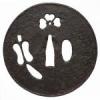I am slowly learning about Owari and Kanayama tsuba. There are a couple of questions I have and would appreciate guidance on.
1. From pictures that I see on the internet and on dealers' websites, and from writing and pictures from Sasano's Early Japanese Sword Guards, there seems to be very little tangible difference between early Owari and early Kanayama tsuba in terms of size, tekkotsu, mimi, dished seppa dai, iron color and texture, open iron work, etc. It is said that Kanayama tsuba are abstract with difficult-to-interpret designs. Some so-called Owari tsuba (by NBTHK papers) have this same trait, too. It's also said (per Sasano) that Kanayama tsuba have "slightly more oblong seppa dai." I have a hard time understanding how one can say A is Owari and B is Kanayama when a lot of the times, it can go either way. The difference seems to be open to personal interpretation. Can someone please help me understand?
2. In Sasano's "Early Japanese Sword Guards," he was adamant that iron tsuba should not be handled with bare hands. On the other hand, it seems to be the consensus of this board that it is safe to handle iron tsuba by hand. How do I reconcile the difference?
Regards,
Hoanh


